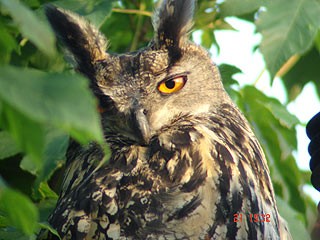 |
| Eagle Owl: Heanor, Derbys (photo: Daniel Martin). |
A TV programme this week highlighted the fact that Eagle Owls were breeding in Britain. Over 20 young have been ringed at a nest in North Yorkshire, one of which was recovered this year as a fatality in Shropshire. It has been suggested that there may now be a breeding population of 40 pairs in the UK. Some birdwatchers, such as Roy Dennis, argue that Eagle Owls should be encouraged here, just as they are in places like Sweden where captive-bred birds have been released into the wild. But the RSPB takes a much more cautious view, based on the official assumption that the Eagle Owl has not occurred naturally in this country and therefore must be treated as an alien species. Here, Julian Hughes, RSPB head of species conservation, elaborates on their position:
The RSPB believes that there is little evidence that the Eagle Owl has occurred naturally in the UK in recent centuries, and that the birds currently breeding in northern England are likely to have escaped or been released from captivity.
A dossier on the Eagle Owl was compiled when its status was being assessed by the British Ornithologists' Union Records Committee in 1996. An extensive review revealed around 90 reports of this species since 1684. Eagle Owl has been known in captivity in this country since at least the 17th century. After careful consideration, the Committee concluded unanimously that many of the descriptions (where available) were not adequate to allow the unequivocal elimination of alternative species. Of those where the identification as Eagle Owl was accepted by the Committee, members were equally united in believing that the possibility of escapes, releases and confusion over the provenance of skins could not be dismissed. There was no evidence that this species has occurred in the wild state in Britain and Ireland for over 200 years, and the species was therefore removed from Category B of the British and Irish List.
The Historical Atlas of Breeding Birds in Britain and Ireland (S Holliday 1996) does not mention the Eagle Owl, and neither does England's Birds (English Nature 2005). The Shell Book of British Birds (James Fisher 1996) has two references. Firstly, bones have been found in Norfolk as Pleistocene fossils (500-600,000 years ago). Secondly, there is a reference to records of it as 'possibly native' in the 8th-11th centuries, but nothing more definite.
Efforts to remove the small numbers of Eagle Owls breeding in the UK may be justified, if it can be shown that they are having, or likely to have, a negative impact on native species, whether as prey or competitors. We believe that the departments responsible for coordinating government policy on non-native species in each country within the UK (e.g. Defra in England) should assess the likely impacts and consult interested parties on its suggested response.
Taking a longer view, there is no doubt that eagle owls are spreading in Europe and that truly wild individuals may appear in the UK in the future. If this were to be shown conclusively, then the status of the Eagle Owl in Britain would change (this is analogous to other species such as Collared Doves and Cetti’s Warblers).
For more information on the RSPB's position, please see http://www.rspb.org.uk/policy/species/eagleowl/index.asp

